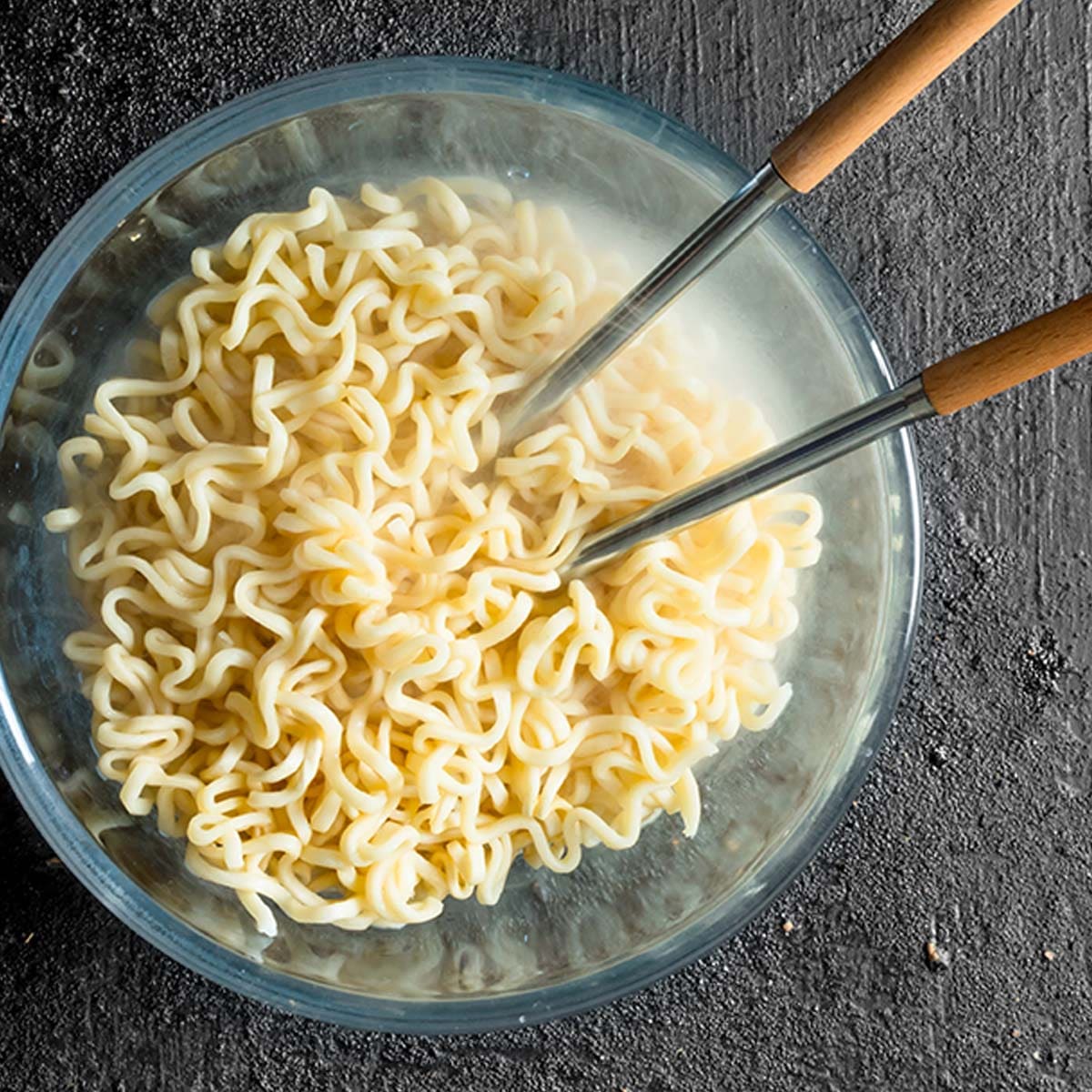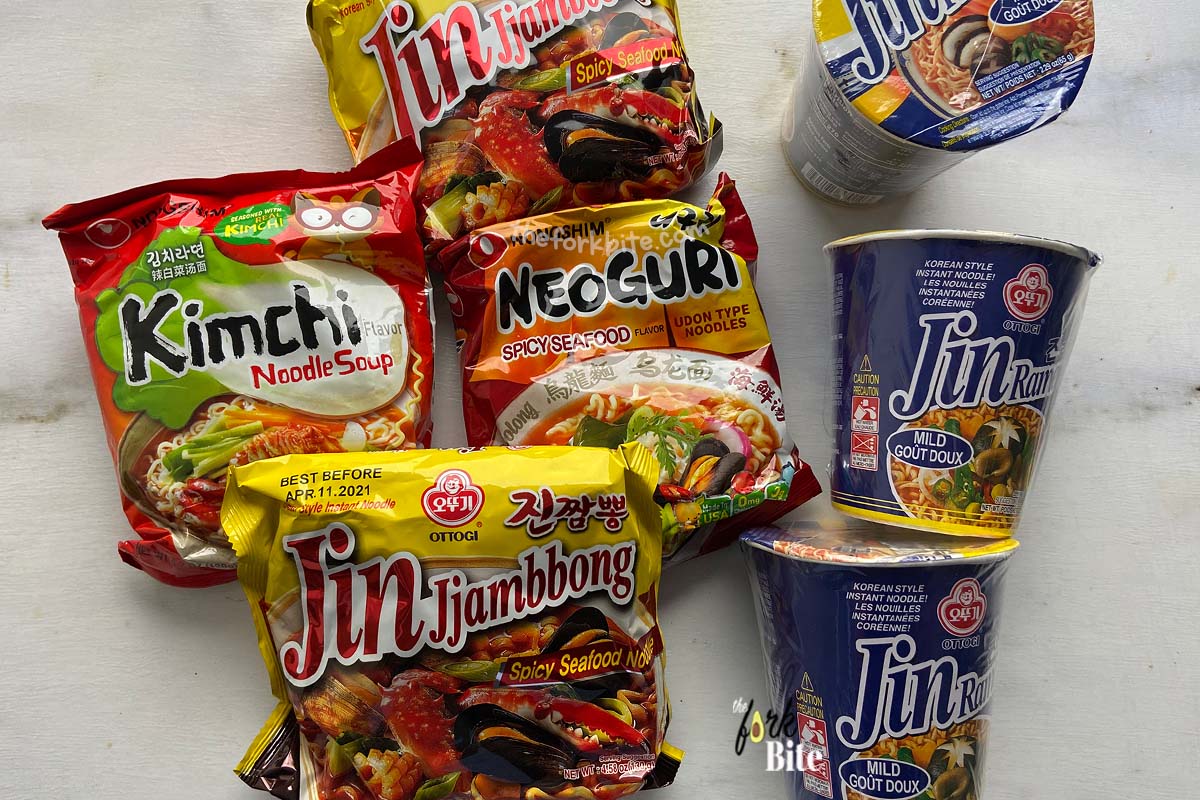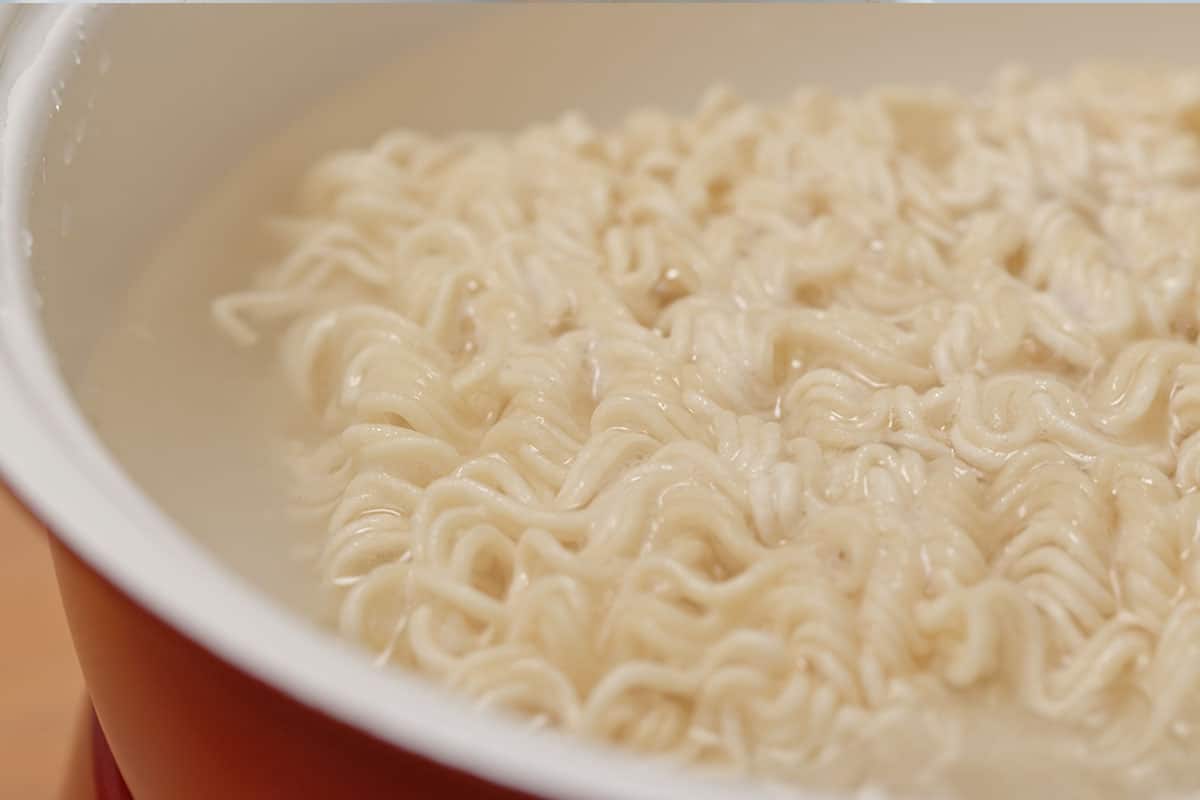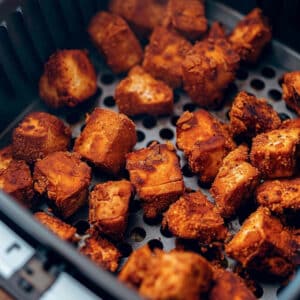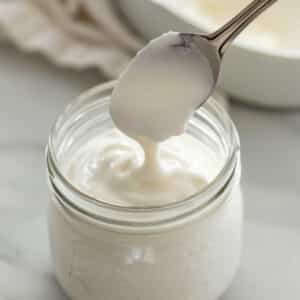Cup Noodles have become a firm favorite with people of all ages, especially young people and college/university students. They are such a convenient, speedy way of having a quick snack with the minimum of fuss. Not only that, but they are delicious too.
It's hardly surprising that they have become a fixture, not only in student accommodation kitchens but in the kitchen cupboards of so many homes across the US.
Jump to:
Being as fast to prepare, you might not think anyone would consider microwaving them, but they do. So, I thought I should step up to the mark to answer the question that many people ask.
Can you microwave cup noodles?
The quick answer is that you shouldn't microwave them. Some foods are okay to microwave, whereas, with others, it can be dangerous.
If you read the information printed on the outside of the cartons, it clearly says that it is not safe to put Cup Noodle containers into the microwave.
The recommendation is that you boil some water, pour it into the carton covering the dried noodles until it reaches the "fill line," then wait for three minutes, after which they'll be ready to eat.
It is not recommended to microwave cup noodles because of the absorption factor, which we go into below.
Why you can't microwave cup noodles
If you read the instructions on a Cup Noodle carton, you won't find anything about cooking them in your microwave. Quite the opposite.
What you will see are explicit warnings telling you to avoid microwaving.
It all boils down that two reasons that support this approach: how the product will react to microwave emissions.
Both reasons have to do with the carton, which has not been designed with microwave heating in mind.
- Firstly, suppose you subject a Cup Noodle carton to the superheating effect of microwaves. In that case, you could unknowingly be promoting the leaching of noxious chemicals from the material carton contains directly into the noodles.
- The other serious concern is that by subjecting the container to microwave emissions, you could compromise the carton's structural integrity. The reason is that container was designed to hold boiling water, to which it is impervious.
Microwaves work by superheating all of the carton's structural components - not just those that have been deemed to be safe against hot water, but others, which ordinarily didn't need to come into the equation.
So, it shouldn't be a surprise if superheating these other components results in the carton's structural failure.
It all amounts to following any instructions and warnings printed on food product packaging to keep safe.
How do you know if they're microwave-safe or not?
As advised above, the first place to start regarding a product's recommendation for microwaving is what is printed on the product's packaging.
The instruction will tell you how to go about safely heating the contents. It may even provide you with an illustration or two.
Please bear in mind that the product manufacturer will have researched the safest methodologies, taking any container restrictions into their calculations.
If you have reasons to doubt the manufacturer's recommendations, the safe thing to do is take up your concerns directly with the manufacturer via their website. Don't try a general internet search because there is a lot of dodgy information out there. Go straight to the horse's mouth.
Do microwaving cup noodles cause cancer? health risks of noodle cups
A medical article recently suggested that you might increase your chances of getting cancer by eating products whereby you had to prepare them by putting hot water into plastic or styrofoam containers.
It reported that styrene could leach into hot water poured into Styrofoam bottles and cups. The temperature of the water was a significant factor in how much leaching of noxious chemicals takes place. Basically, the higher the temperature, the greater the amount of leaching.
The report concluded that you should not use polystyrene type products for food packaging and that rigid polystyrene, in particular, should not be incorporated into the manufacture of rigid foam styrene cups, especially those used to dispense hot drinks.
As far as Cup Noodle plastic containers are concerned, scientists at Goethe University surmised that the estrogenic compounds they contain could leach into any hot water poured into them.
You can find out more about this phenomenon from the article published on the abc.net website.
Besides, while it appears that paper cups are okay, those made from cardboard are susceptible to this type of compound leaching.
Is ramen bad for me?
This question doesn't really fall within the remit of this article; however, you will find some information published below, and you can click here to find out what the USDA has to say about Ramen. Read and make your own mind up.
Preparing cup noodles the right way
I will now tell you about the options there are for making a perfect Cup Noodle snack. However, you do need to adhere to what I am about to say to you. Just bear in mind that continually boiling the product for five minutes or more is going to mean you end up with sorry, soggy, limp noodles.
Option #1 Making packaged ramen
Step 1 Take the noodles out of the packaging
There are two preferred options when preparing your Ramen Cup Noodles.
- Option one is to bash the noodles while still inside the sealed bag to break them into small shards that you can easily eat with a spoon.
- Option two is to leave them in their block form and heat the whole thing. The choice is yours.
Step 2 Place the noodles into a microwave-safe dish and pour in enough water to immerse.
- Dependent on the size of the bowl or container you use and how much broth you prefer to have in the finished dish, you will require from one to two cups of water.
- So you don't get any "splatter" while microwaving, you should either put the lid loosely in place if using a lidded container, or if not, cover with a piece of paper kitchen towel.
- The noodles may float in the water (especially if they've been broken up), but that is not a problem. They will still cook just fine.
- Some sorts of plastic and Styrofoam containers are considered contentious. Due to ongoing concerns about BPA and other toxic substances being leached into food products when coming into direct contact with packaging, microwaving can exacerbate.
Step 3 Microwave for about 3 to 4 minutes
- Put the bowl and its contents into your microwave. Depending on its power rating, heat for between three and four minutes. The exact cooking time may vary as each microwave works differently.
- Halfway through the cooking time, give the noodles a quick stir with a fork. If you left them in brick form, this is also the time to break them up by pressing down with the fork and agitating them. If you prefer to leave them in brick form, flip them over at the halfway cooking stage to ensure even cooking.
Step 4 Leave the noodles to sit for 3 minutes after the microwave stops
- If you will take the container out of the microwave immediately after your microwave pings, wear oven gloves. The container could be quite hot.
Step 5 Mix in the flavor packet
- It is now a good time to add the flavoring while the liquid is good and hot.
- Whatever you do, please don't eat them straight away. You will risk burning your mouth, something with which many ramen lovers will be only too familiar.
When you mix in the flavoring, use a fork or spoon and stir until the powder is dissolved and evenly distributed. Pour into another dish, eat and enjoy.
Many ramen lovers opt to add the flavoring before heating. Cooking with the seasoning intensifies the taste. Whether you add the mixture before or after you put the water in is up to you.
Just remember that you want your Ramen to be evenly flavored throughout, which is where the stirring comes into play.
Option #2: Boiling water separately
An alternative way of microwaving Ramen is by boiling the water on its own, separately, then adding it to the noodles and allowing them to steep for a few minutes. For those who prefer their noodles to be more al dente, this is the way to go.
Step 1 Pour water into a heat-proof container
Depending on whether you like your Ramen to be more or less brothy, use somewhere between one and a third to two cups of water - whatever your preference - obviously, the less you add, the faster it will come to the boil.
Step 2 Microwave water for at least 2 or 3 minutes.
Due to the way that microwaves act on water atoms, the water doesn't visibly boil and steam as much as it does when you boil it on your stovetop. It may not look boiling.
You will need to microwave for two to three minutes, stirring it a couple or three times during cooking.
When you are satisfied that it is hot enough, remove the container from the appliance and remember to wear oven gloves.
Step 3 Place the noodles into a separate bowl.
As the water is being microwaved, take the noodles out of their packaging and place them into a separate bowl. It's your choice whether you add the flavoring now or after the noodles are cooked.
Step 4 Pouring the boiling water over the noodles
Once the water boils, pour it on the noodles, put it into a separate bowl, and cover it with a paper kitchen towel sheet. Allow it to sit and cool for three to five minutes, after which the noodles will be temptingly soft - eat and enjoy.
When you read the instructions on the Cup O'Noodle or Instant Lunch packaging, you will find them rather vague when it comes to microwaving.
While the jury is still out regarding the dangers of subjecting styrofoam to microwaves, I would recommend going down the route of boiling the water separately and then adding it to the cup instead of running the risk of microwave-melting the cup, which would not be good.
Option #3: Getting fancy
Option 1 Great creative with add-ins and condiments
Don't confine yourself to the limitations of the flavor pack. The prime rule of the Ramen lovers' fraternity is to do your own thing. Don't be dictated to by anyone else. Rather than using the flavoring as is, get creative. Add some of your favorite seasoning and spices.
By sprucing your Ramen up with some additional flavorings, all of which you can buy cheaply from your local grocery store, you can concoct a tasty restaurant-quality dish.
Here are a few tasty seasonings and extras you can consider adding to your Ramen once you remove it from the microwave:
- Basil
- Green Onions
- Hoisin Sauce
- Honey
- Lemon or Lime Juice
- Miso Paste
- Rice Vinegar
- Soy Sauce
- Sriracha Sauce
Option 2 Adding vegetables
You can enhance the flavor of your Ramen by adding some healthy, chopped Thai Basil leaves or a little finely chopped spinach or other vegetables of your choice.
Before cooking the noodles, you can add finely chopped carrots, celery, garlic, or onions. Frozen peas are great for bringing in a little texture, as are some other pre-cooked frozen veggies. Feel free to experiment.
Alternatively, once the noodles are cooked, you can add chopped herbs such as Basil and Cilantro. Other options include adding Rosemary and a tablespoon plus of Chicken Ramen. It gives the Ramen a great savory tweak, reminiscent of Thanksgiving.
Option 3 Amp it up with eggs
If you like egg drop soup, you might be tempted to add this little twist to spice-up your Ramen. You'll have to make sure your stock is boiling, then stop the cooking, add the beaten egg mixture and place the dish back into the microwave for a final cook. Alternatively, you can use chopped hard-boiled eggs instead.
You can also crack an egg into the broth, give a vigorous stir with a fork, then pop it back into the microwave to cook through. It's best not to take any chances with raw egg.
Extra tips:
- When cooking a Cup O'Ramen Noddle dish, I prefer to take the block of noodles and break it in half as it makes it easier to cook and, to my mind, doesn't make any difference to the final product.
- To add even more flavor, try adding chicken broth rather than water.
- The noodles themselves are quite delicate, and therefore, they are best eaten as soon they've been cooked.
- Add something new to a salad; you can break up Ramen noodles into tiny pieces and sprinkle them over your salad to impart a tasty crunch.
- Don't just eat your bowl of Ramen as is, even though it is in itself delicious. Try adding some extra goodies - things like a chopped hard-boiled egg, some pre-cooked veggies, or some shavings of luncheon meat. You are only limited by our imagination.
- If you add the flavor mix to your Ramen after being microwaved, you might find that the taste doesn't get evenly distributed. That's why I usually add the flavoring before microwaving. It does away with the problem.
- Try adding Bacon Bits, Hot Sauce, or Ranch Dressing to your noodles. You'll find it really perks up the taste.
- To give your Ramen a flavor boost, try adding a beef or bacon stock cube. Powdered stock is even better as it mixes in so quickly.
- Adding a little extra salt will also bring out more flavor. How about adding a slice of American cheese? Unusual, yes, but it gives you a great cheesy kick.
- If you like your Ramen on the slightly sweet side, cook a couple of packs, and once they're cooked, drain the liquid off, then add some seasoning, a ¼ cup of milk, and a little knob of butter.
- Another great flavor enhancer is to drizzle in a bit of Sriracha hot sauce and add a slice of lime.
- You can also add the yolk of a soft boiled egg with some crushed black and red peppers, a little mozzarella cheese, and a few drops of hot chili sauce.
Don't forget that every microwave is different, so you may need to adjust the cooking time.
Frequently asked questions
The best way of spicing up a Ramen noodle dish is to add a little hot chili sauce. Sriracha, black pepper, Cheyenne pepper all work well.
It’s a matter of personal choice. Both Hoisin and Soy sauce are great. However, like me, if you like a little spice, try adding a few drops of Sriracha sauce along with a bit of lemon or lime juice. I also find that a mixture of Soy and Spicy Bean Paste plus a little lemon or lime works well.
Yes, it is. It’s something I’ve been doing for years to prevent any splatter, and I’ve never had a problem.
A glass bowl or any other microwave-safe container and that won’t melt during the cooking process is an acceptable alternative. Just bear in mind that some glass is thinner and therefore more fragile than others. Choose one that is reasonably thick and microwave-safe.
Either will do, but of course, the dish will take longer to warm through if you start with cold water.
Final Thoughts
Enjoying Cup Noodles as an occasional treat won't do anybody any harm; in fact, if anything, the weight in between heightens the anticipation.
As with most things, indulging too frequently rubs the shine off. Eating in moderation ensures that Cup Noodle Ramen will always remain high on your list of favorites.
Interesting posts
Prepare the cup noodles the right way (How to)
Pin RecipeIngredients:
- cup noodles
Instructions:
Option #1 Making Packaged Ramen
STEP #1 Take the noodles out of the packaging
- Option one is to bash the noodles while still inside the sealed bag to break them into small shards that you can easily eat with a spoon.
- Option two is to leave them in their block form and heat the whole thing. The choice is yours.
STEP #2 Place Noodles in Microwave-Safe Dish
- Place the noodles into a microwave-safe dish and pour in enough water to immerse.
- Dependent on the size of the bowl or container you use and how much broth you prefer to have in the finished dish, you will require from one to two cups of water.
- So you don’t get any “splatter” while microwaving, you should either put the lid loosely in place if using a lidded container, or if not, cover with a piece of paper kitchen towel. The noodles may float in the water (especially if they’ve been broken up), but that is not a problem. They will still cook just fine.
- Some sorts of plastic and Styrofoam containers are considered contentious. Due to ongoing concerns about BPA and other toxic substances being leached into food products when coming into direct contact with packaging, microwaving can exacerbate.
STEP #3 Microwave for about 3 to 4 minutes
- Put the bowl and its contents into your microwave. Depending on its power rating, heat for between three and four minutes. The exact cooking time may vary as each microwave works differently.
- Halfway through the cooking time, give the noodles a quick stir with a fork. If you left them in brick form, this is also the time to break them up by pressing down with the fork and agitating them. If you prefer to leave them in brick form, flip them over at the halfway cooking stage to ensure even cooking.
STEP #4 Leave the noodles to sit for 3 minutes after the microwave stops
- If you will take the container out of the microwave immediately after your microwave pings, wear oven gloves. The container could be quite hot.
STEP #5 Mix in the flavor packet
- It is now a good time to add the flavoring while the liquid is good and hot. Whatever you do, please don’t eat them straight away. You will risk burning your mouth, something with which many ramen lovers will be only too familiar.
Please note that all nutrition information are just estimates. Values will vary among brands, so we encourage you to calculate these on your own for most accurate results.



